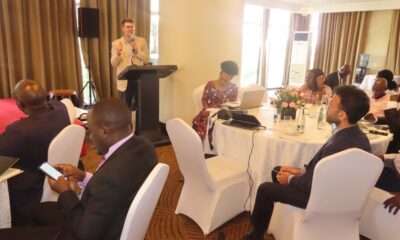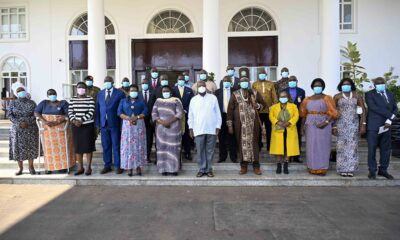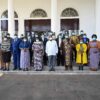News
President Yoweri Museveni’s speech at the Commemoration of the Africa Industrialization Day-Verbatim
I congratulate all Ugandans, especially the Industrialists, wealth creators, and innovators on this day, as we join the rest of Africa to commemorate Africa Industrialization Day.
This year’s theme, “Promotion of Inclusive and Sustainable Local Manufacturing to Bolster Uganda’s Industrial Sector” is in line with the objectives of the National Development Plan III and the NRM Manifesto 2021-2026, on industrialization.
This day presents an opportunity for Uganda and Africa to take stock of our industrial progress so far and chart a way forward for the development of the industrial sector. This will be accomplished through the widening of our production base and leveraging our resources to focus on areas where Uganda has a comparative advantage.
Africa has abundant natural resources, including oil, gas, metals, agricultural and forest products, and the blue economy.
Africa’s natural resources are estimated at USD $30 trillion in potential wealth. This makes Africa one of the wealthiest places on earth. Despite these vast and diversified natural resources, Africa is still home to some of the Developing and Least Developed Countries in the world. This is on account of Africa’s dependency on the export of raw materials and importation of manufactured products from the Developed Countries, limited value addition, the volatility of commodity prices, and the export of jobs.
For instance, if you consider our agriculture, the prices of coffee beans will always fall, but, not the price of brewed coffee; the price of cotton will always fall, but not so the prices for apparel and textiles; the price of cocoa will always fall, but not so the prices of chocolate.
The Industrial Sector contributes 27.6% to Uganda’s GDP: with Mining and Quarrying contributing 2.0%; Manufacturing 15.8%; Electricity 1.3%; Water 2.3% and Construction 6.6%. This is still below the 35% threshold which we need to make us sustainably competitive and move us towards achieving the Middle Income Status. We have registered some progress in processing raw materials into semi-finished goods and recently, in the assembly of products from imported inputs and components.
The NRM Government has, since 1986, been pursuing strategic measures to industrialize the country, with considerable levels of success. We have made calculated steps in addressing the ten strategic bottlenecks that hindered the industrialization drive. Among these is a lack of infrastructure, such as electricity, roads, railways etc. which results in high costs of doing business in an economy that undermines the profitability of companies and therefore limits their expansion; a narrow internal market that cannot absorb the products of large scale manufacture of goods and expansion of services.
Infrastructure development (like the Roads, Water and Air transport, Railways; energy and ICT backbone) is critical for industrial growth. The total paved roads as a percentage of total national roads have increased to 21.1% (5,500km) in 2019 from 8% (1,000km) in 1986. The electricity generation currently stands at 1252.4 Mega Watts, while transmission lines cover 2,989 km and the Government is determined to reduce the cost of electricity for manufacturing industries to 5 cents of USD (Ugx 185) per unit from the current 8.7 cents of USD (Ugx 321) per unit. For the ICT, the optical fibre network covers 2,424 km.
Another important factor is market access. The Country has registered significant milestones in integrating our markets using the East African Community (EAC), the Common Market for Eastern and Southern Africa (COMESA), Tripartite Free Trade Area (TFTA) and the African Continental Free Trade Area (AfCFTA). There are also the USA’s African Growth Opportunity Act (AGOA) and the European Union’s ‘Everything But Arms’ (EBA). We are working together under the African Union, in the Pan-African spirit, to ensure the free movement of goods and services across the Continent by removing tariffs and Non-Tariff Barriers (NTBs), border restrictions, road-blocks on trade routes and complicated licensing procedures, etc.
By ensuring peace, infrastructure development and establishment of bigger markets, Uganda has become a preferred destination for foreign investors. As I had stated earlier, there are two major categories of people in an economy; the investor (both local and foreign) who are the producers of goods and services and the consumers. These two have a symbiotic relationship in the economy: the more the investments, the more the jobs, which increases the income of consumers. Increased income results into effective demand for more goods, which is an impetus for increased production and productivity.
The NRM Government has also made significant strides in Human Resource Development to drive industrial growth. They include; the establishment of Institutions in the area of skilling; and the deliberate measures of increased remuneration of scientists as impetus for innovation.
Before the outbreak of the COVID-19 Pandemic, the GDP growth was at 6.5% in FY2018/19, which was 0.3% higher than the growth registered in FY2017/18. Industry was the main driver of this growth, expanding at a rate of 10.8%, followed by agriculture (5%) and services (4.9%). With the developments in the Oil Sector in the Albertine Graben since 2006, the economy will be growing at the rate of between 9 – 10% in the initial years of oil production. It is therefore estimated that the economy will expand to an estimated USD 67 billion (purchasing power parity exchange rate) by 2026.
The COVID-19 Pandemic has shown us the need for adaptability to the prevailing needs of both the local and global markets. Our textile and garmenting industries diversified into production of face masks, Sugar Industry into production of refined sugar, Alcohol Industry into production of hand and medical-grade sanitizers, plastic manufacturers and recyclers producing hands-free wash-tanks and other water dispensers etc. This adaptability is not limited to the above mentioned industries. The maize and cassava processors should progress into the production of starch and the cocoa and vanilla producers to making chocolates.
In my Article on the real economy vs vulnerable economy (April 2020), I highlighted fourteen (14) agricultural products whose industrial value chains have so far not been fully exploited and we are losing to other Countries. These foreign Countries reap the biggest value-percentage from producing finished products.
The Government is working with the Private Sector to ensure environmentally sustainable industrial development in the Country. Currently, our industry emissions contribution to global warming have not yet escalated out of hand. In fact, carbon-dioxide emissions from industrial processes in Uganda are still very low at 0.65% when compared with other Sectors like; Forestry (59.5%), Agriculture (26.9%), Energy (10.7%), and Waste (2.3%). This industrial Green House Gases (GHG) contribution is still manageable for now, but it is important to note that as industry grows, so will the emissions from the industrial processes.
This is why we must start putting in place mitigation and adaptation measures to these anticipated or projected carbon-dioxide emissions as a way to ensure sustainability.
In conclusion, I wish to mention that Industrial manufacturing can earn Uganda ten times what it earns from Agriculture. The source of Uganda’s greater wealth will come from having strong manufacturing capacity for competitiveness in regional trade and integration into global value chains.
I thank you all.












































